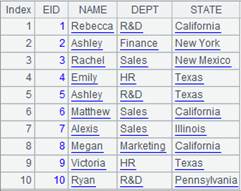x.nodes@r(Fi,...)
Description:
Expand the referencing field(s) through multilevel of recursion.
Syntax:
x.nodes@r(Fi,...)
Note:
The function expands the referencing fields in parameter x through multilevel of recursion.
When parameter x is a single value, return an empty sequence;
When parameter x is a record and if the specified Fi,… fields all have single values, return a sequence consisting of x; otherwise return x.Fi.nodes@r(Fi,... )|...;
When parameter x is a sequence or a record sequence, return x.conj(~.nodes@r(Fi,...)).
When parameter Fi is absent, traverse all fields of x.
Parameter:
|
x |
A single value/a sequence/a record. |
|
Fi |
The field name. |
Return value:
Sequence
Example:
When parameter x is a single value:
|
|
A |
|
|
1 |
=rand(10) |
Return random values within 10 |
|
2 |
=A1.nodes@r() |
Return [].
|
When parameter x is a single record or a sequence:
|
|
A |
|
|
1 |
=demo.query("select * from DEPARTMENT").keys(DEPT) |
Return a table sequence:
|
|
2 |
=demo.query("select NAME,ABBR from STATES").keys(NAME) |
Return a table sequence:
|
|
3 |
=demo.query("select top 10 EID,NAME,DEPT,STATE from EMPLOYEE") |
Return a table sequence: |
|
4 |
>A3.switch(DEPT,A1:DEPT) |
Convert A3’s DEPT field into the referencing field according to the corresponding value of A1’s key field DEPT. |
|
5 |
>A3.switch(STATE,A2:NAME) |
Convert A3’s STATE field into the referencing field according to the corresponding value of A2’s key field NAME; After A4 and A5 are successfully executed, A3’s sequence becomes this:
|
|
6 |
=A3.select@1(NAME=="Ashley") |
Get the first record where NAME value is Ashley from A3:
|
|
7 |
=A6.nodes@r(EID,NAME) |
Get records where both EID field and NAME field are single values and return them as a sequence.
|
|
8 |
=A6.nodes@r(DEPT,STATE) |
Get records where both DEPT field and STATE field are single values and return them as a sequence:
|
|
9 |
=A6.nodes@r(DEPT) |
Get the record where DEPT field is the single value and return it as a sequence:
|
|
10 |
=A3.nodes@r() |
As parameter Fi is absent, traverse all fields of A3 to get records where all fields are single values and return them as a sequence: |






